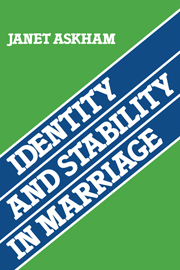Book contents
- Frontmatter
- Contents
- Preface
- 1 Prologue
- 2 Ways of looking at marriage: an introduction to the study
- 3 Knowing and talking to each other
- 4 Separate and joint activity
- 5 Constraints on behaviour within marriage
- 6 Changes in self and in activities
- 7 Relationships outside marriage
- 8 Conclusion
- Appendix 1 Sample selection
- Appendix 2 Interview guide
- Appendix 3 Profiles of the couples
- Glossary
- Bibliography
- Index
2 - Ways of looking at marriage: an introduction to the study
Published online by Cambridge University Press: 07 October 2011
- Frontmatter
- Contents
- Preface
- 1 Prologue
- 2 Ways of looking at marriage: an introduction to the study
- 3 Knowing and talking to each other
- 4 Separate and joint activity
- 5 Constraints on behaviour within marriage
- 6 Changes in self and in activities
- 7 Relationships outside marriage
- 8 Conclusion
- Appendix 1 Sample selection
- Appendix 2 Interview guide
- Appendix 3 Profiles of the couples
- Glossary
- Bibliography
- Index
Summary
Theoretical approaches to the study of marriage
The types of question raised in the previous chapter about the ends pursued in marriage do not fall neatly into either of the main theoretical approaches so far used in the study of marriage by sociologists. Leaving aside studies not explicitly tied to any theoretical framework (a situation far from uncommon in this field), there have been two major theoretical approaches: functionalist and conflict or exchange theory (the former waning, the latter still influential).
The functionalist approach is not without relevance to the study proposed here, but it must be largely rejected on account of its tendency to direct attention to the macro-social context rather than to interaction between individuals, and of the assumptions it makes about the relationship between the behaviour of individuals or small groups and the wider society. As far as marriage is concerned (as opposed to the family in general, or parent–child relations), functionalists have been most interested in sex-role divisions, and are well-known for their distinction between the instrumental role of the husband and the expressive role of the wife (Bell and Vogel 1960; Coser 1964; Parsons 1959; Parsons and Bales 1955). In so far as such an account of marriage merely directs one's attention to the likelihood that married people will be constrained in their adoption of marital roles by the expectations prevalent in their society, and that there might be a constellation of roles one could call ‘instrumental’ and another which one could call ‘expressive’, then it is of use to someone planning to study marriage relationships.
- Type
- Chapter
- Information
- Identity and Stability in Marriage , pp. 14 - 31Publisher: Cambridge University PressPrint publication year: 1984



